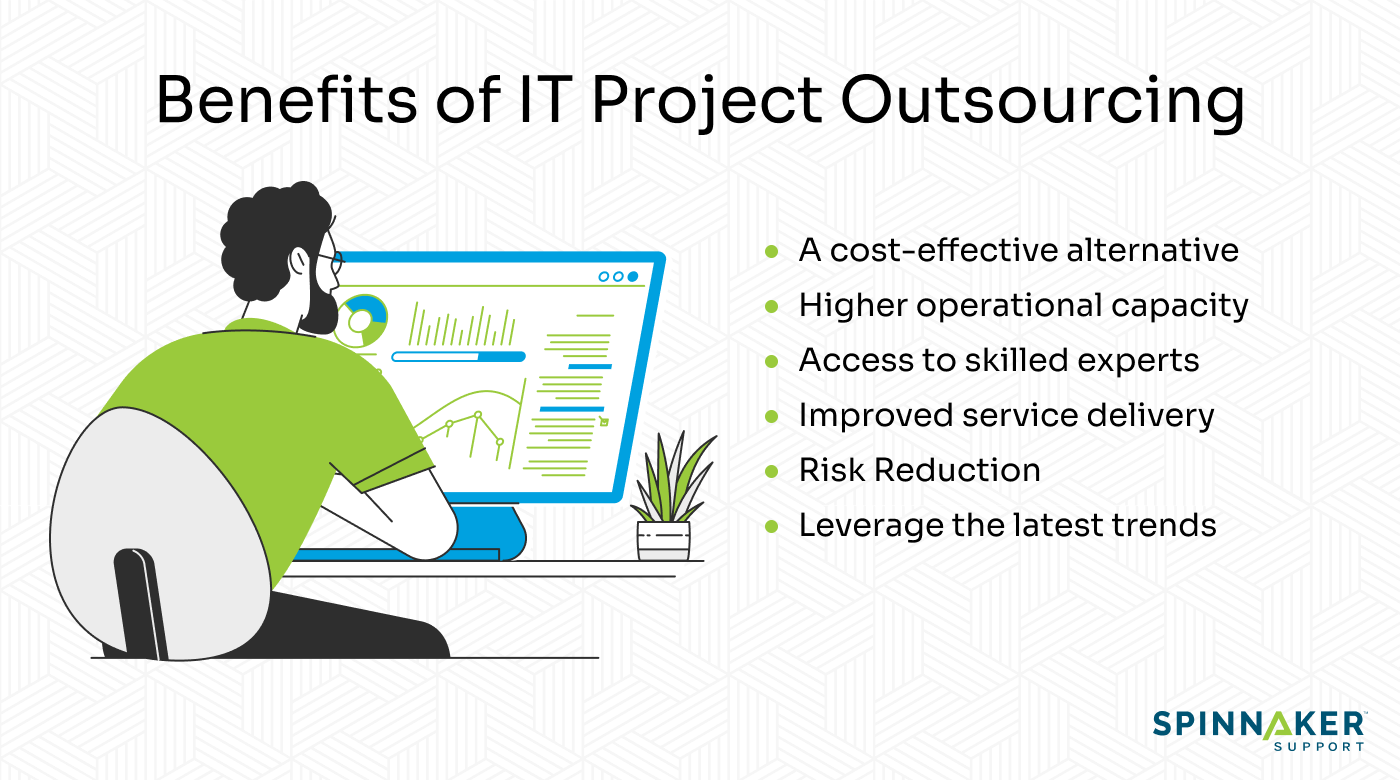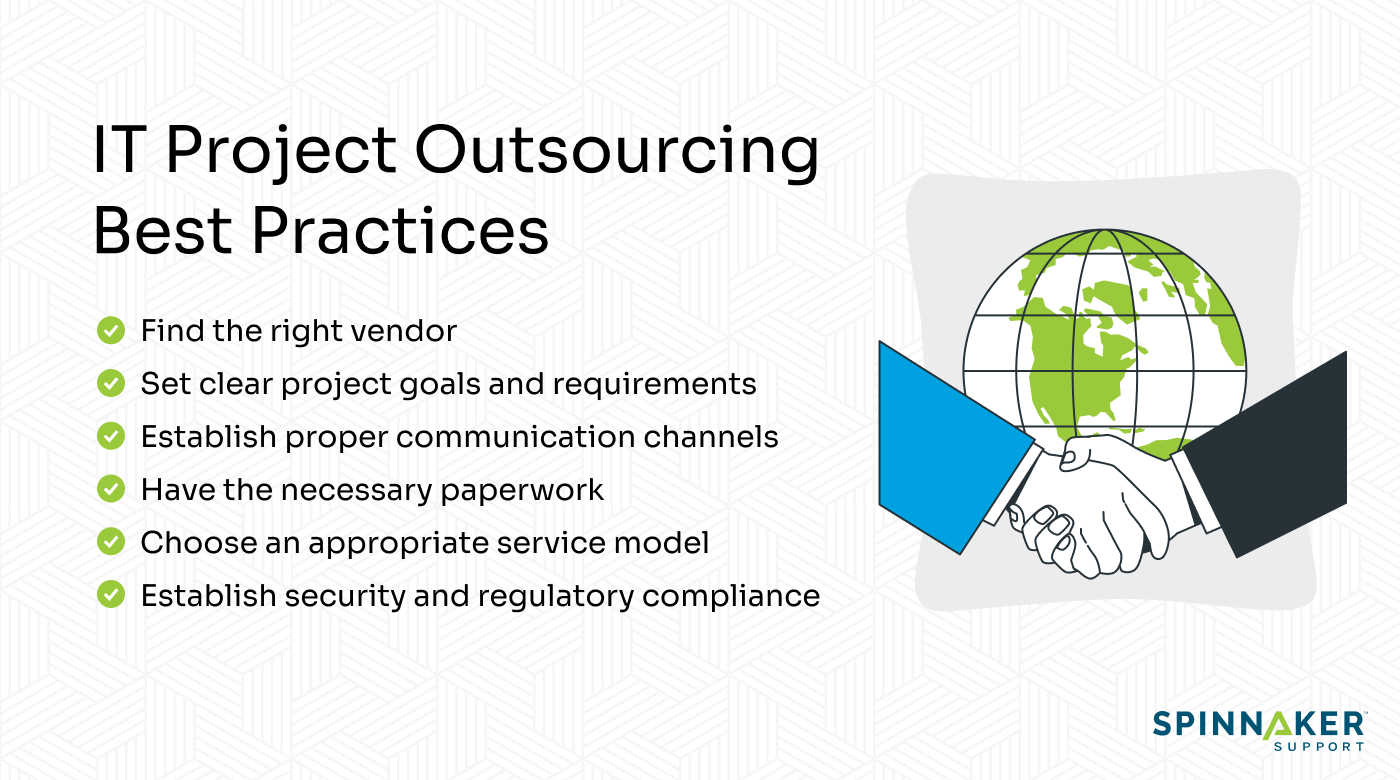Many organizations have significant growth potential but struggle to scale efficiently due to budget constraints and a lack of available talent. IT outsourcing offers a strategic approach to filling these gaps.
While there are many benefits to outsourcing IT projects, there are also some potential challenges. So, what do you need to know before you decide to outsource?
This article will review the benefits, drawbacks, and best practices for IT project outsourcing. We’ll also look at the future of project outsourcing and why Spinnaker Support is a good partner for dedicated project support.
What is IT project outsourcing?
IT project outsourcing is the process of hiring external service providers to handle whole or certain parts of an IT project. Companies may choose to outsource projects like software development, cloud migrations, network upgrades, security upgrades, and more.

With limited resources and the pressure to innovate, reduce costs, and increase operational efficiencies, more companies are opting for IT project outsourcing.
Outsourcing allows you to work on core business tasks through an external supplier rather than in-house. You define a contract and a Service Level Agreement (SLA) that binds you and your partner to specific project deliverables.
Since external service providers have more knowledge, resources, and lower costs, companies often choose to outsource rather than manage every part of a project themselves.
What are the benefits of IT project outsourcing?
The trend of outsourcing IT projects is growing. The global IT services outsourcing market shows no signs of slowing down, going from an initial valuation of $530.15 billion in 2021 to an estimated value of around $1.06 trillion by 2030.
But what are the benefits of IT project outsourcing?

Let’s take a closer look.
A cost-effective alternative
Outsourcing to a dedicated team can help mitigate the expense of employing an in-house IT specialist full-time. You can leverage outsourced expertise without paying for the full cost of hiring and managing your own team.
Additionally, outsourcing support and maintenance to third-party providers can help you save on vendor support costs. For example, when Partner Communications wanted to reduce its Oracle software maintenance fees while at the same time significantly improving their level of support through personalized service with ready access to experienced support personnel, they recognized significant cost savings of greater than 60% annually.
Higher operational capacity
Outsourcing frees up your internal team’s time to pursue other projects. You can prioritize core business goals as you take advantage of the advanced technology and knowledge that outsourced specialists can provide.
Access to skilled experts
If your company is running a short-term project requiring specialized skills, you might have difficulty finding the right talent pools or developing it in-house. In that case, you can benefit from outsourced expertise by getting access to diverse talent globally.
Improved service delivery
In order to stay competitive, outsourcing companies work hard to maintain high standards of service delivery. As such, you can get higher quality services with faster turnarounds. For example, if you are looking to accelerate development cycles for specific projects, outsourcing can help you speed up delivery timelines.
Risk Reduction
Third-party providers have more industry-specific knowledge, making them better able to handle security or compliance risks. Through outsourcing, you are able to spread project risks to the external team. You can also define contracts and SLAs to ensure accountability in project delivery.
Leverage the latest trends
Outsourced teams often have ready access to cutting-edge tech and can execute innovative solutions depending on your business objectives. For example, within two days of the publication of the Log4j vulnerability, Spinnaker Support began analyzing it and distributed its first draft response.
Spinnaker Support was able to stay one step ahead of the competition because we stayed informed on new vulnerabilities cropping up in the cybersecurity landscape.
For IT project outsourcing and managed services, Spinnaker provides project-based consulting and 24*7 monitoring and maintenance support to multiple products across the globe.
What are the drawbacks of IT project outsourcing?
With all the benefits that come with IT project outsourcing, there are certainly a few disadvantages.

Here are potential drawbacks of IT project outsourcing.
Quality concerns
The quality of the work is the primary concern of approximately 56% of companies when outsourcing software engineering projects. Outsourcing to an extended team means you might have to deal with different work practices and standards that may affect deliverables.
One way to ensure the team you are outsourcing to understands and aligns with your business objectives is to vet each partner beforehand properly. You can look for case studies of previously done projects, including reviews from their customers.
Hidden costs
Outsourcing can cut operational costs, but hidden fees such as transition costs and management oversight may offset the savings expected. Hence, it is essential to discuss with a potential partner and lay out well-defined SLAs before enlisting their services.
Security concerns
Unlike working with in-house teams, outsourcing means you will likely share sensitive data with external parties. To avoid data breaches and unauthorized access, the outsourcing partner must have robust security measures.
Additionally, you need to ensure that all of your software has updated patches in case of any potential vulnerability. If you have lost access to vendor security patches, you can reach out to Spinnaker Support to address your security concerns.
Communication issues
The outsourced team and client may experience problems with regular communication due to different time zones, language, or cultural differences. In this case, you can select a partner that closely meets your needs and has a track record for fast responses.
For example, Salesforce says, “Spinnaker was the ideal partner to move quickly and architect an elegant, effective Salesforce solution that met our business needs.”
IT project outsourcing: How do you make the right choice?
Although there is a good selection of IT outsourcing and third-party support companies, finding a partner that understands your business operations is crucial.

Here’s what to look for.
Relevant industry experience
First, establish that your potential outsourcing partner has relevant industry experience. You can do this by going through case studies to see if they have worked with clients in your industry before. You can also schedule a call with them to learn more about their services.
Good communication practices
Second, analyze whether your partner has effective communication practices and customer service. Whether you have chosen an offshore or onshore partner, you should be able to raise issues and have them addressed quickly.
For example, Ajith Kumar, Senior Manager of ERP Applications at Autodesk, says, “Unlike SAP support, Spinnaker Support doesn’t resort to stall tactics or attempt to force unnecessary patches on customers in an effort to “try” to fix problems.”
Proven track record
Finally, look out for high-scoring reviews and proof of project completion. Your outsourcing partner should have a proven track record of meeting project deliverables for previous clients.
Spinnaker Support, for instance, features several customer success stories for SAP, Oracle, and JD Edwards customers who outsourced their IT projects to them. You can, therefore, go through our customer success stories and case studies to establish if we are the right fit for you.
IT project outsourcing best practices
Outsourcing comes with a host of benefits, but for it to be successful, there are several best practices you should keep in mind.

Let’s have a look at best practices to consider in more detail.
Find the right vendor
You need to find a suitable outsourcing partner with a history of success in projects similar to yours. Check for a track record of completing projects and good customer reviews.
You also need to decide whether to offshore or nearshore your outsourcing needs. You should look at factors such as time zone differences, work culture, and language barrier to establish what kind of partner fits your business processes.
Set clear project goals and requirements
You must set and discuss your project goals and requirements with your outsourcing partner. Make sure the outsourcing partner understands your business objectives.
For example, if you’re planning a cloud database migration, you can let your outsourcing partner know that your main objective is to move your application data quickly with minimal disruption to everyday workflows.
Additionally, you need to define how much you want to outsource, whether it is the entire project or just sections. You are more likely to meet expectations if your objectives are clear and detailed.
Establish proper communication channels
You and your outsourcing partner need to define the communication channels clearly. Having meetings, regular updates, and effective communication options helps get things done quickly and ensures everyone is on the same page.
Have the necessary paperwork
Before outsourcing your IT projects, you need to have an SLA to define workflows, timelines, and deliverables. An SLA should address all your concerns and doubts regarding the whole process.
Other necessary paperwork may include the following:
- A Non-Disclosure Agreement
- Key Performance Indicators
Choose an appropriate service model
IT project outsourcing comprises three service models. Your current team needs to analyze your business requirements and select the model that best fits your use case.
The three service models include:
- Delivery teams: The outsourcing team collaborates in parallel with your in-house team.
- Staff augmentation: The outsourcing firm complements your current staff with additional skilled workers.
- Project-based outsourcing: In this model, your outsourced partner assumes complete control of the IT project.
Establish security and regulatory compliance
Ensure your external service provider complies with security and relevant regulatory requirements based on your industry.
Spinnaker Support offers a holistic approach to security and regulatory compliance. Our global security team actively advises on security issues and keeps an eye out for vulnerabilities.
The future of outsourcing IT projects
If your company has limited resources and it is difficult to access skilled talent, you may experience several shortcomings. For example, enforcing security policies without an experienced team of experts in place can leave your company exposed to vulnerabilities.
Among companies with a low level of cyber maturity, 38% don’t follow any best practices for cyber defense. As such, more and more companies will be looking to outsource their IT projects to increase their security posture, among other benefits.
Moreover, more companies continue to adopt cloud-based infrastructures. We expect that the global cloud computing market will grow at a rate of 14.1% per year from 2023 to 2030 after reaching a value of $483.98 billion in 2022.

Cloud computing’s ability to improve business performance will contribute to the growth. Increased cloud usage means more companies will begin prioritizing a smooth lift and shift migration with minimal risks. We will see more companies outsourcing their cloud adoption and maintenance processes to stay ahead of the curve.
Further, we will likely see increased Artificial Intelligence (AI) adoption in outsourced workflows. This is because the number of enterprise software engineers using AI coding assistants will rise from less than 10% in early 2023 to 75% by 2028.
Incorporating AI into project delivery and support services means faster and better service delivery. As outsourcing partners begin to leverage the power of AI, companies will start to see increased efficiency, faster project delivery, and a higher quality of service.
Thus, when looking at the future of IT project outsourcing, it’s clear that more companies will continue to embrace outsourcing.
Conclusion
When your organization’s IT demands are dynamic, you might find it expensive to build in-house resources to handle the increasing volume of IT projects. As such, IT project outsourcing becomes a viable option.
Spinnaker Support has a team of experienced personnel who are ready to bring in expert assistance. You can reach out to a support expert to get started with your outsourcing journey.


